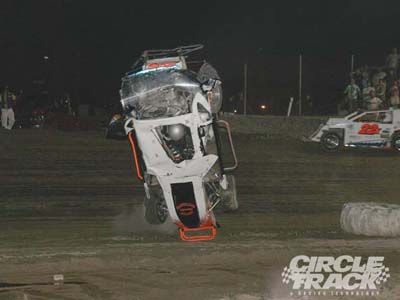
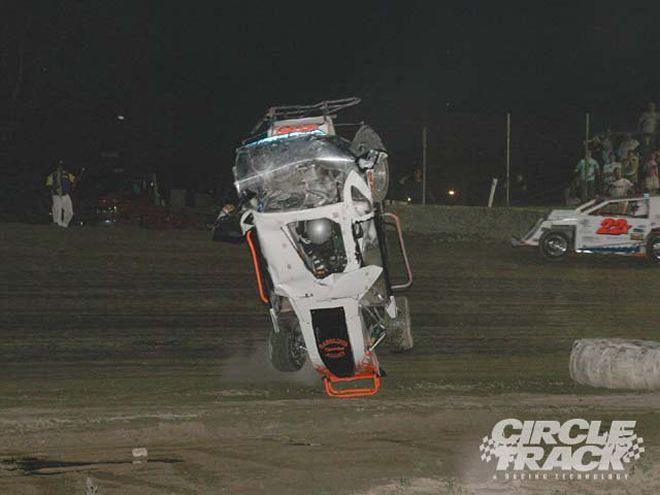 There are still horrific crashes happening in stock-car racing. The good news is we have a survival rate much higher now than at any time in history. That being said, we can't rest on our successes. We all need to be diligent where safety is concerned and work to design the safest environment possible in which to race.</br> JOE ALEXANDER
There are still horrific crashes happening in stock-car racing. The good news is we have a survival rate much higher now than at any time in history. That being said, we can't rest on our successes. We all need to be diligent where safety is concerned and work to design the safest environment possible in which to race.</br> JOE ALEXANDER
Race car safety includes a number of areas of concern. We have the actual chassis design, the various add-ons to that chassis that are available, the seat and restraint equipment, our fire systems, the driver's apparel, and the design of the racetrack that influences our safety. Those, along with the team's level of safety awareness all add up to what should be a high level of survivability.
At some point in our preparation for the new season, we need to address, review, analyze, plan, and enact safety measures that will help prevent serious injury or death in the event of a crash. Staying safe from harm is of utmost importance and we need to be thinking about all of the factors that go into that well before anything happens. Here are the major areas of interest concerning race car safety.
Basic Chassis Design One of the most critical areas of concern for chassis design is stiffness. Over the years, racers have been seriously injured and killed by the force of impact with the wall or other objects. The injury that results in the leading cause of death in these types of crashes is basil skull fracture. It's the very same injury suffered by someone who is hung by a rope.
In short, death is caused by the body stopping in a very short distance for a very short duration of time, and the head continuing forward at a high rate of speed. The neck is not designed to hold back this extreme force and the tendons that hold the skull and vertebrae together break with extreme damage to the brainstem, spinal cord, and blood vessels.
BOB BOLLES">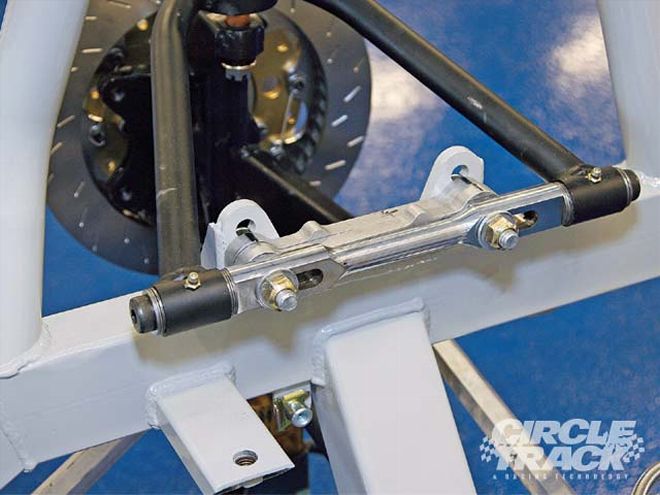 It's the framerail that needs to bend in order to absorb the energy created by contact with the wall. If these rails are straight and/or too stiff, then the g-forces--up to 70 g's in some cases--have no where to go but into the driver. A head that weighs 15 pounds becomes 1,050 pounds instantaneously in a 70 g hit.</br> BOB BOLLES
It's the framerail that needs to bend in order to absorb the energy created by contact with the wall. If these rails are straight and/or too stiff, then the g-forces--up to 70 g's in some cases--have no where to go but into the driver. A head that weighs 15 pounds becomes 1,050 pounds instantaneously in a 70 g hit.</br> BOB BOLLES
The impact with a wall or light pole or other fixed object while traveling at a high speed generates a lot of energy. The more time it takes for the speed to be reduced to zero, the less g-forces that are transmitted to the driver's body. Something must give and move in order to extend this time sequence. Either the wall (or whatever is struck) must move or give way, or the car must crush. It's the crush factor, be it the object struck or the vehicle, that helps us survive.
In past years we've seen some horrific crashes that were survived or not due to the level of crush factor. In the truly stock race cars of the 1960s and 1970s, speeds were reached that equal or exceed today's stock car speeds. Drivers hit the wall at very high speeds with much less adequate protection than we had in the 1990s, but survived. Why?
Cars of yesteryear were built on the original chassis. These frames were stamped into a shape that was convenient for attaching the body and suspension parts and there were lots of curves and hardly any straight pieces. Curves in steel parts easily bend. So, as these cars struck the concrete walls, the chassis bent and absorbed much of the energy of the crash. Injuries and deaths started occurring when we started fabricating special chassis for racing that had more straight lines and less curves.
BOB BOLLES">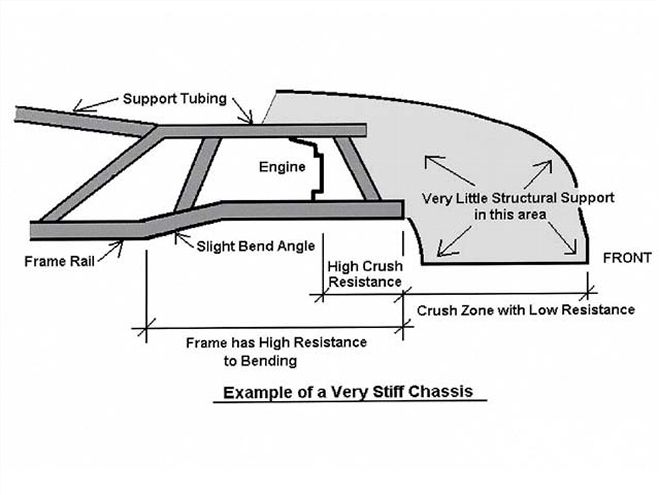 This is an example of a stiffly designed chassis. There's very little angle formed when the main rail extends forward from the firewall. This causes the front chassis to be very stiff and not absorb much energy in a crash. Cars built similar to this were a cause of injuries and fatalities in the late 1980s in the Northeast Modified series.</br> BOB BOLLES
This is an example of a stiffly designed chassis. There's very little angle formed when the main rail extends forward from the firewall. This causes the front chassis to be very stiff and not absorb much energy in a crash. Cars built similar to this were a cause of injuries and fatalities in the late 1980s in the Northeast Modified series.</br> BOB BOLLES
Today there are a majority of race tracks that have naked concrete walls without energy absorbing coverings. All of the crush factors must be designed into the race car chassis if we expect to dissipate the energy of a crash. Race car builders must be aware of this need as they design a new chassis. If not, the driver of that car is at risk.
Intrusion Protection One of the more rare injuries we see with race cars is when outside objects protrude into the car and injure the driver. The object can be a driveshaft separated from another car, a lost bumper, the end of a guardrail, a tire and wheel that has come off another car, and more. We need to provide protection from intrusion with our chassis design.
Plating the side bars help prevent side intrusion and this plating should extend forward to protect the front of the foot box. Netting beside the driver's head helps keep the head and arms inside the car, but can also keep objects out of the cockpit too.
BOB BOLLES">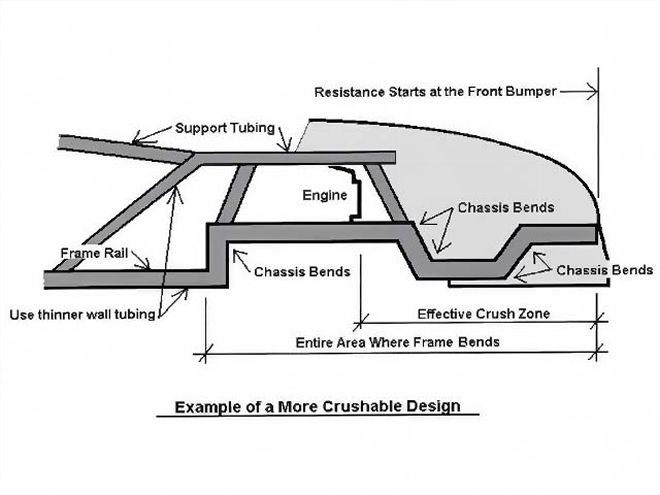 A better design would have the framerail built with lots of bends with high angles at the joints. This provides a lot of bending possibilities making for a softer crush zone which will dissipate energy and reduce the g-spike we see in hard impacts with the concrete walls.</br> BOB BOLLES
A better design would have the framerail built with lots of bends with high angles at the joints. This provides a lot of bending possibilities making for a softer crush zone which will dissipate energy and reduce the g-spike we see in hard impacts with the concrete walls.</br> BOB BOLLES
Remember to plate the underside of the seat along with welding bars in the windshield area to keep out flying objects of a larger size. Seal the firewall and interior sheetmetal seams that are needed to keep out dirt, exhaust gases, and flames. Inspect them often.
Padding All exposed tubing, the steering column, and other hard equipment inside the cockpit must be padded with dense cell padding material intended for race car use. Foam-type padding is usually not stiff enough to dissipate the energy of a flying arm or leg. The stiffer material may seem a bit hard to the touch, but when hit hard, will absorb the energy without collapsing, or squashing down to the bare metal.
It's a similar concept as helmet foam. That medium is hard to the touch, but conforms to the shape of the head on impact and absorbs much of the energy. Attach padding to all of the exposed rollbar tubing within reach of the driver's arms and legs. An especially neglected area is between the legs, along the steering column. The mount, bolt ends, and shaft all can cause serious bruising or fractures of the bones if not adequately padded.
There are pads now available for the door bars, seat sides and back, head restraints, and steering wheel center post. The more padding you can use, the safer you will be and the more comfortable, too, when utilizing seat and leg padding.
BOB BOLLES">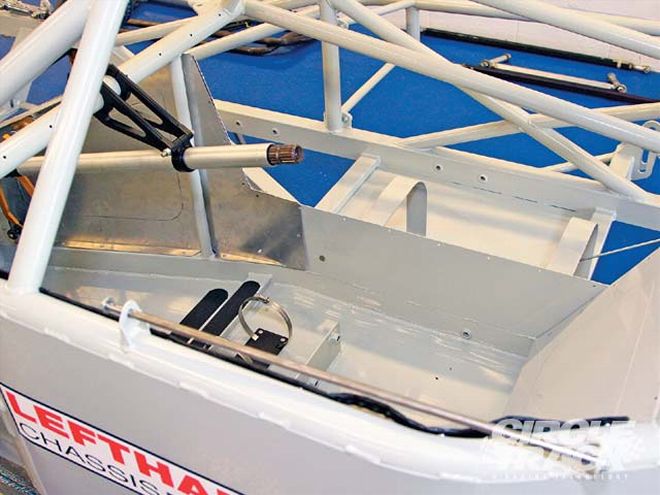 This car has plating along the side of the driver's compartment outside the 'cage. This, along with more plating beside the foot box, helps prevent objects from intruding into the driver's compartment. We need not forget to plate under the driver's seat for added protection.</br> BOB BOLLES
This car has plating along the side of the driver's compartment outside the 'cage. This, along with more plating beside the foot box, helps prevent objects from intruding into the driver's compartment. We need not forget to plate under the driver's seat for added protection.</br> BOB BOLLES
Seats and Accessories The racing seat along with the seatbelts, arm restraints, netting, and head and neck restraints are the primary line of defense against personal injury or death in a race car. Aside from fire protection, your first thought and concern should be to install a quality seat that fits your body perfectly. Then fit seatbelts that will hold you in the seat properly, along with netting that will contain your extremities.
Generic seats are cheap and I understand racing budgets. If you can't afford a custom seat built to your body's dimensions, then at least buy a size that fits snug. You can also add foam padding specifically designed for seats so that you can't move around in the seat.
When I raced karts, my seat was shaped so that I had to turn my hips to enter the seat and then the hips were locked in tight when I was fully in. This provided a lot of support and reduced the movement from the 3-plus g's we experienced while road racing. I would be bruised along the sides of my hips and legs from the side force, but never felt like I was not firmly in the seat. As you go through the turns, the lateral loads must be contained by the seat against the body, and with some seat designs, the shoulders.
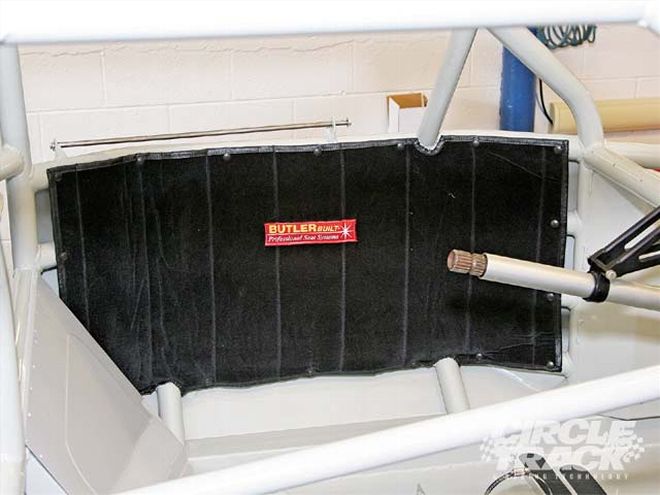 Many companies offer padding for covering the side bars next to the seat. Hard side impacts force the arms into the bars. Many seats have extensions that protect the legs from side impacts too. Donft forget to pad that steering column while youfre at it. BOB BOLLES
Many companies offer padding for covering the side bars next to the seat. Hard side impacts force the arms into the bars. Many seats have extensions that protect the legs from side impacts too. Donft forget to pad that steering column while youfre at it. BOB BOLLES
There's a proper way to mount the seatbelts, and every manufacturer has specific instructions on how to do that. Read and follow the instructions. If you're the driver, do a visual inspection of the installation before you get in the car and drive it. The nets should be tight, with no slack in either the vertical or horizontal direction. Memorize where the release levers or cords are located to release the nets.
Fire Control The danger of fire in stock cars has been greatly reduced, but not entirely eliminated. With the introduction of fuel cells, fire suppression systems (fire extinguishers), firesuits, and fireproof materials, the risk of getting burned is much less than ever before. The level of protection though is up to the driver.
There are different levels of firesuit protection available with escalating cost as the level increases. Opt for the best system you can afford, relative to the risk you're willing to accept. That is, imagine the worst case scenario and design your system so that you'll survive. Make regular inspections of the fire control system a part of the maintenance schedule and put it on a checklist. I see teams overlook this item a lot.
BOB BOLLES">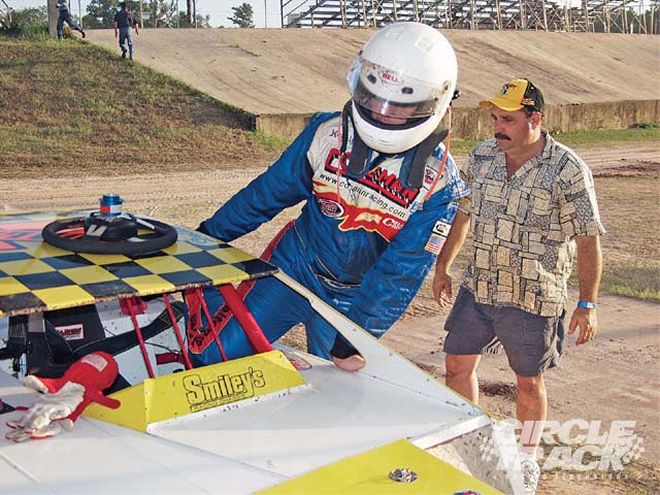 This is what we like to see. A driver entering his Dirt Modified with a high SFI-rated firesuit, full coverage racing helmet and head-and-neck restraint, and fireproof gloves and shoes. Don't think that you don't need all of these safety features to run on dirt. The same types of injuries can occur on any racetrack.</br> BOB BOLLES
This is what we like to see. A driver entering his Dirt Modified with a high SFI-rated firesuit, full coverage racing helmet and head-and-neck restraint, and fireproof gloves and shoes. Don't think that you don't need all of these safety features to run on dirt. The same types of injuries can occur on any racetrack.</br> BOB BOLLES
Consult with the experts to see if there are new designs that might be more efficient or cost effective for your type of racing. At year's end, remove and inspect all of the components of your fire control system. Make sure the nozzles are clear and the tubing is not crushed or bent. Have the bottle inspected by the manufacturer and refilled if necessary.
Safety Apparel What will allow you to survive a fire is the clothing you wear. Each racing suit, glove, and shoe has a fire rating. That's the measure of how long you can go before you get burned. In a best case event, the car catches fire and you exit in 10 seconds or less. Good for you. But wait, there are other circumstances that may extend the time it takes to exit the car that you might not have thought of.
Here are some mitigating circumstances that might occur to delay your exit of the car when it's engulfed in flames: 1) loss of sight, from smoke and/or flames, which is needed to find the window-net latch, belt latch, and so on, 2) the driver's side of the car is against the wall or other cars necessitating exit out the other side of the car, 3) the car is upside down, 4) you forget to unhook the radio cord, air hose to the helmet, your head and neck support, and so on, 5) you're stunned from a high impact with the wall or other cars and must regain your awareness, the worst case being knocked out.
The problems that can arise will add seconds to the time it takes to exit the car. The best case time of 10 seconds or less now turns into 30 seconds or a full minute. Do this exercise; sit and look at your stopwatch and imagine you're in a burning race car and get the feel for how long 10 or 30 or 60 seconds is. I just did that here at my desk and I can tell you, a minute is an eternity. Only the best-rated suits will protect you for that period of time.
BOB BOLLES">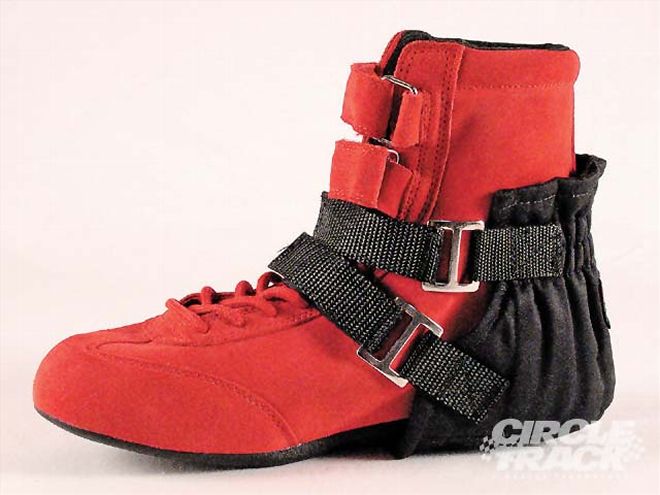 A good pair of fire resistant shoes are a necessity and there are accessories you can add such as the heel boot that reduces the heat transmitted to the foot from hot headers lying just outside the footbox. These items do a good job of cooling the feet and don't interfere with exiting the car in a hurry if need be.</br> BOB BOLLES
A good pair of fire resistant shoes are a necessity and there are accessories you can add such as the heel boot that reduces the heat transmitted to the foot from hot headers lying just outside the footbox. These items do a good job of cooling the feet and don't interfere with exiting the car in a hurry if need be.</br> BOB BOLLES
What greatly increases the protection time is fire-rated underwear. The Nomex brands really help and the Carbon X or similar designs are incredible. An SFI rating becomes up to twice as effective with proper underwear. All of this may add up to a higher cost or less comfort in hot weather, but imagine for a second the alternatives. You could end up lying in a burn ward for upwards of several months with the loss of income for your family, and permanent disfigurement. Gee, decisions, decisions.
Track Design The conditions at your track can have a profound effect on the safety level for not only the drivers and crews, but spectators as well. We need to be concerned about how our local track prepares for problems. It's your responsibility to evaluate your racetrack for safety and make known any concerns to the owner.
RANDY ELLEN">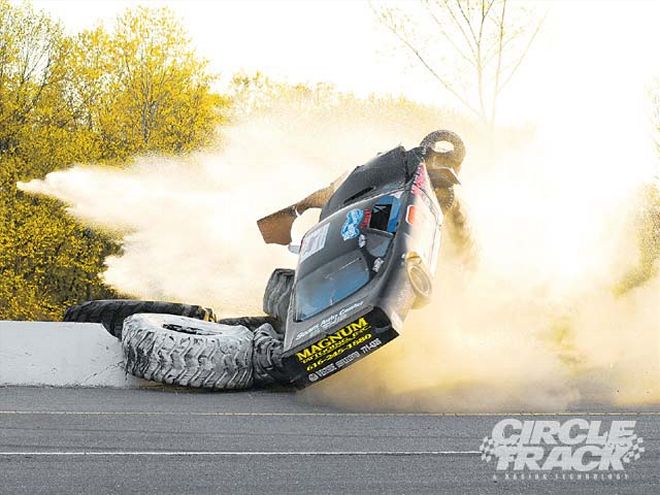 Racetrack managers and owners owe it to the racer to provide a relatively safe environment. A good fire truck and a professional medical crew with ambulance are just two critical items that are needed. As for the design of the track, any ends of concrete walls or metal guardrails should be protected with large heavy-equipment tires. These can dissipate lots of energy to help prevent injury to the drivers. The driver in the crash shown here survived and walked away with no injuries. He was also wearing a head-and-neck restraint system.</br>RANDY ELLEN
Racetrack managers and owners owe it to the racer to provide a relatively safe environment. A good fire truck and a professional medical crew with ambulance are just two critical items that are needed. As for the design of the track, any ends of concrete walls or metal guardrails should be protected with large heavy-equipment tires. These can dissipate lots of energy to help prevent injury to the drivers. The driver in the crash shown here survived and walked away with no injuries. He was also wearing a head-and-neck restraint system.</br>RANDY ELLEN
Every track must have emergency personnel for trauma, fire fighting, and extraction. An ambulance with trained medical technicians is needed and a dedicated fire truck should be on hand. If you have to wait on an ambulance or fire truck to be dispatched to the track from the community, especially in rural areas, you can bet you'll be in a world of hurt if you're seriously injured with internal injuries and/or burns. Time is of the essence in an emergency and safety personnel should be at the track, not at the coffee shop down the road.
The design of the facility can be improved with just a little forethought. The ends of concrete walls or steel guardrails must be protected. Large, used commercial tires offer a lot of protection from impact. Plastic barrels filled with sand or water also provide impact protection. Dirt berms and restraining barriers that will contain the cars and prevent entry into the pit area also help to prevent injury to bystanders.
It might be a good idea to form a safety committee at your track. It can be composed of a combination of track officials and race team members. Working together, you can reduce any safety problems before they arise. It's in all of our interest to race as safely as possible.